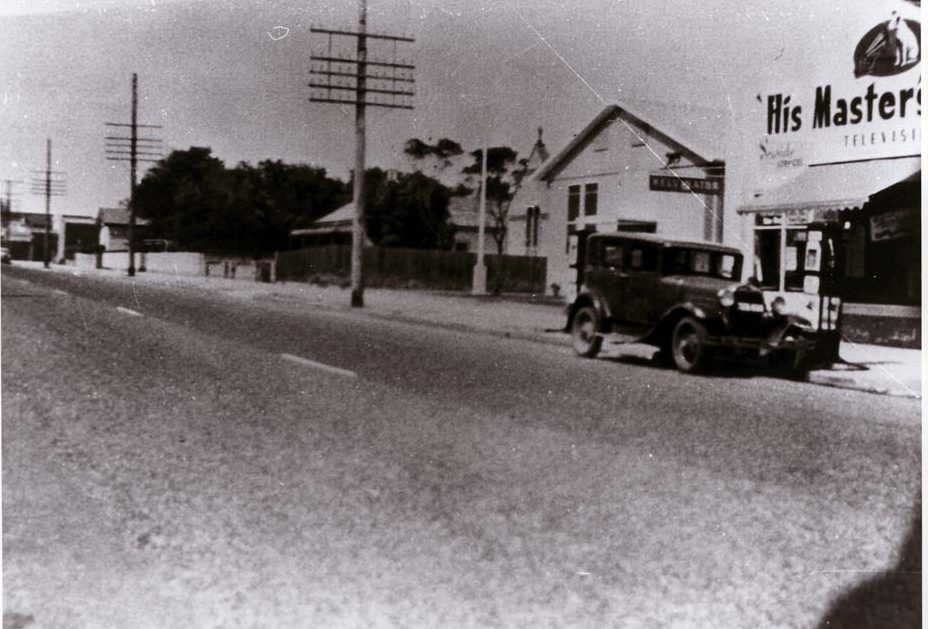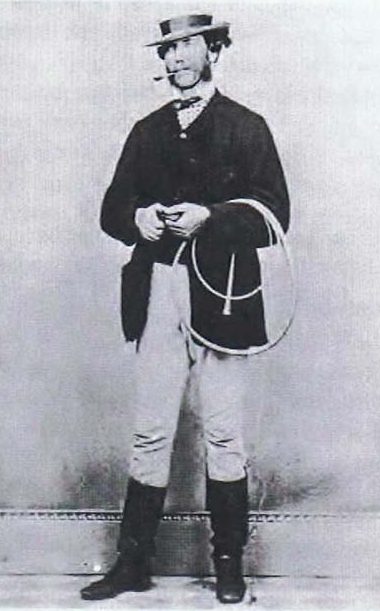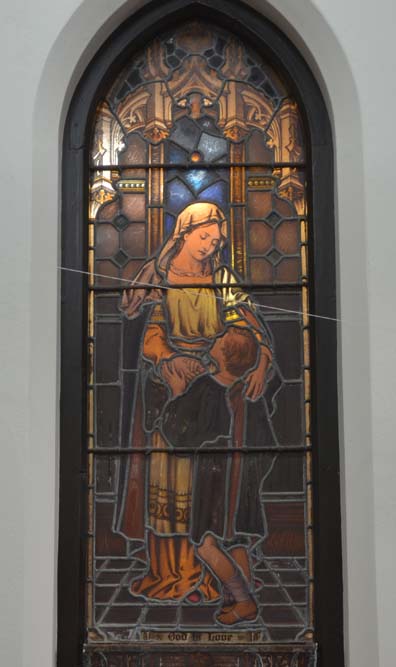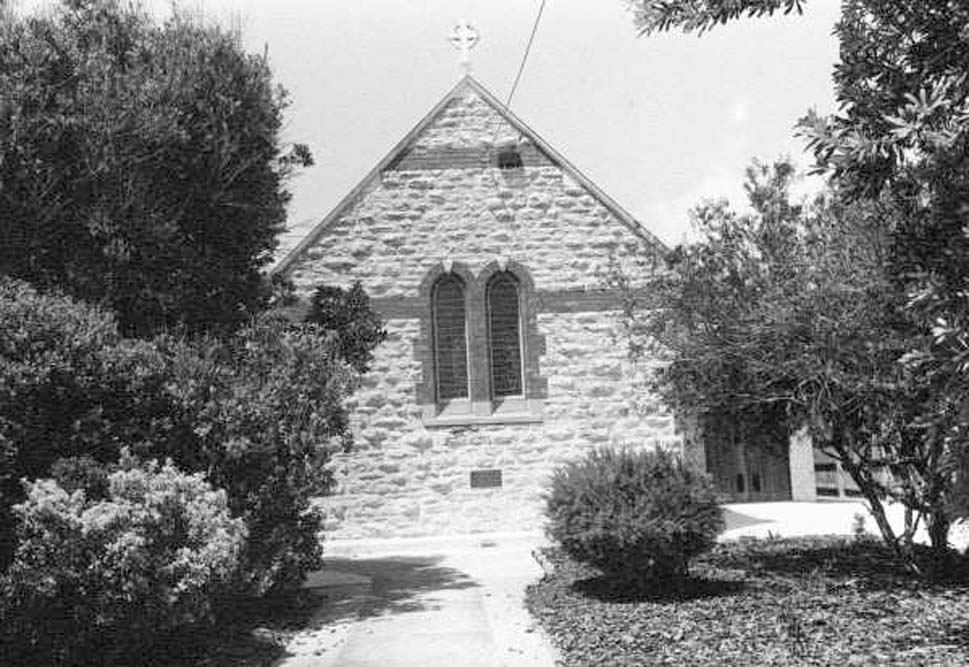
By Keryn Rivett
Nestled between a three-storey apartment block and a busy shopping plaza is a little, limestone church, dwarfed by its modern neighbours. When these places were built it was feared the little church would all but disappear in the shadows of these giants, but the contrast of the buildings around it just emphasises the pioneering charm of St Mark’s Anglican Church Dromana.
In the 1870’s, the fledgling community’s worship services were held on the foreshore amongst the banksia opposite Mrs Warren’s confectionery shops and tearooms, but it was soon decided that the township needed a more formal place of worship. In 1877 a meeting was held in Rudduck’s Store and it was decided that a church would be built for all denominations to use; attending this historic meeting were Mr H Robinson, Messers Barnett, Snell, N. Dyson, Burns, Boag, Ninnes, W. Gibson, A Gibson and J Gibson, J Cairns, G Henderson and N Rudduck. After many places were considered, a site was chosen and plans drawn up, but over the ensuring few months this attempt failed through lack of interest. Other attempts also failed due to dissension amongst the many strong personalities resulting in resignations and replacements. In the end it took thirty-nine months and many hurdles to finally complete this ‘unified’ church. It was decided that the Church of England and the Presbyterians would take turnabout on alternative Sundays. However, it seems harmony was never quite achieved and arguments ensued over various issues like the care and maintenance of the lamps and the position of the organ! Dissension just got worse and by 1886 the relationship had broken down irretrievably and, after more resignations, only two men remained.

George McLear (1840-1918), born in Campbelltown, New South Wales of Irish parents represented the Church of England and Walter Gibson (1829-1916), born in Scotland, represented the Presbyterians; both men were notorious for thwarting each other and it appears they simply wore everyone else down. McLear was known for his rigidity when it came to rules and Gibson would not compromise – one man wanted to sell the church, whereas the other wanted to keep it and neither of them would budge. Family dinners must have been interesting because Walter Gibson’s son Adam was married to George McLear’s sister Mary Ann! All appeared helpless and for the ensuring four years a deadlock remained. How were they to break this impasse and come to a decision as to what was going to happen to the church? Peace came in the shape of a store owner in 1891 when it was discovered that Nelson Rudduck, a Londoner (1849-1935), may have resigned as a trustee but, his name was never removed from the trustee’s list. Rudduck stepped back in as an Independent, broke the deadlock and the sale of the church finally went ahead. This original interdominational church was sold for cash to the Presbyterian congregation and, on 19 September 1891 the net profit of five hundred and fourteen pounds, eight shillings and sixpence was split three-ways.
During this deadlock, on the 17 January 1891, members of the Church of England had met and decided it was time they had their own church in Dromana. In July 1891 the Bishop of Melbourne, Dr Field Flowers Goe and Mrs Goe, attended a service where the Bishop confirmed sixteen people and the following day there was an event to raise funds for the construction of a stone church in Dromana for the Church of England congregation.

On 24 September 1891 a meeting decided to purchase a forty-foot block of land abutting The Esplanade (Point Nepean Road) which went through to Gibson Street. With architects Hyndman and Bates supervising and solicitors Wynne and Co. keeping a close eye on proceedings, building was commenced by George Morce of Sorrento, with the memorial stone being laid on the 7th November 1892.
R Adams (possibly Captain Robert Henry Adams) of Rosebud donated 10,000 bricks which were transported to the site by George McLear. Godfrey Burdett Wilson carted the sand and metal for the foundations and the stone was carted by John Dyson. The church was designed in the neo-gothic style and constructed of dunn limestone with red brick masonry blocks on the corners and rendered parapets at the gable end.

St Mark’s Anglican Church Dromana was dedicated on 7 April 1893 by the aforementioned Bishop of Melbourne, Dr Goe and assisted by the Revs. B N White and Frederick Willcox. One hundred and twenty people attended the service.
The church bell has done more over the years than draw the faithful to their services; it was also used to warn the townsfolk of any emergencies including bushfires and landslides at The Rocks (Anthony’s Nose); if that bell rang, the people gathered. Unfortunately, the bell is now permanently welded into silence after it was discovered it was in danger of falling onto the footpath the next time it was rung, bringing bell and tower down on to some poor unsuspecting pedestrian. One hundred years of ringing a bell in a limestone building had taken its toll.
The building which now houses St Mark’s Op Shop, was once the parish hall. Built in 1958 it hosted many a local dinner dance, community gathering, wedding reception and Sunday School activities. In 1989, a parish office was built into the hall and the Op Shop, which is still operating today, was opened.
In 1981, the old vestry (a small room on the side of a church) was demolished and replaced with an entry foyer (known as a Narthex), toilets were also added and in 1988 O’Donohue Street was made, providing new access into the church.
By the 2010’s St Mark’s was rapidly outgrowing its premises and it was decided a transportable building would be installed. In 2012 a generous donation of $12,000 was provided by the Bendigo Community Bank of Rye, Rosebud and Dromana to allow this to happen. This afforded a place to be used for Sunday School and is affectionately known as ‘Mark’s Place’. It is also used for meetings and storage.
The stained-glass windows of St Mark’s were all installed by Brooks Robinson & Co. of Elizabeth Street, Melbourne, a major stained-glass firm which started in the 1850s as importers of glass but, by the 1880s, were producing their own. Brooks Robinson & Co. employed a number of different glass artists over the years, so there is often considerable variation in the style and quality of their windows. Generally, the earlier glass is much better than that produced in the later years. One of the reasons for this is the difficulty of getting good artists and most firms re-used designs rather than drawing up new ones, so you will often see the same windows in a number of churches. There are windows by Brooks Robinson & Co in many Victorian churches.
There are eight stained-glass windows in St Mark’s and whenever the church is open visitors are welcome to come and see them:
“God is Love” is a memorial to Mrs Maria Wilson. This window depicts a girl and a boy reflecting Jesus’ love of children. When the Narthex was added in 1981, this window ceased drawing light from outside and is now rarely seen in its full beauty.
“The Good Samaritan” is a memorial to Ben Wilson. This window is a representation of the parable of a man who is set upon by robbers, a priest passes by without helping him as does another man (notice the distant figure down the path).
“The Birth of Jesus”is a memorial to Coralie Violet and Francis Alfred Burmah. This double window is in two parts, the first part on the left is the representation of the Nativity with Joseph, Mary, the baby Jesus and a lamb. The second part of the window is a representation of Jesus in the temple where he was consecrated.
“St Francis of Assisi” is a window dedicated to Kimberley John Bailey who died in 1972 aged 14 and represents Saint Francis of Assisi, the Patron Saint of Animals. It is interesting to note the inclusion of Australian native animals in this design. The artist for this window was Mr Derek Pearse.
“Jesus Heals the Paralytic” is a memorial to Dr James Charles Weld, one of the first doctors in the District, who died in 1923. It portrays one of Jesus’ healing miracles and was designed by Brooks Robinson in 1923.
“Faith” is a memorial to Robert and Mary Bodycomb, their children and descendants including their great-grandson Edward Miles Beaumont who was a Pilot Officer. This window depicts the nature of Faith and is based on the Parable of the Ten Virgins. Faith is represented by the female figure, ever ready for the return of Christ, her lamp lit for God who calls people out of the darkness; the cross a sign of being true to Christ.
“The Sanctuary Windows” were the first stained glass windows placed in the church and are a memorial to Godfrey Burdett Wilson who died in 1919. The main window is in a traditional style and forms a triptych representing the ascension of Christ. The small windows underneath, which are in a more modern style, also form a triptych and are a symbolic representation of Jesus – the crown represents Him as more than a king, the chalice in the middle is the vessel used during Communion and the palm represents Jesus’ entry into Jerusalem.
“St Mark” Patronal Window was given by the parishioners and friends of St Mark’s as part of the church Centenary celebrations of 1992-1993 in thanksgiving for the pioneers of the church. St Mark, the writer of one of the Gospels, and obviously represented here because of the name of the church, is often depicted with a lion, which is his symbol.
St. Mark’s is the Mornington Peninsula’s third oldest Anglican stone church and is only pre-dated by St. John’s in Sorrento (1874) and St. Andrew’s in Rye (1882).

From the beginning, St Mark’s was part of the Parochial District of Sorrento but over time it became part of a new parish with Rosebud and McCrae. In 1988 St Mark’s combined with St George’s in Red Hill forming, yet again, another new parish until 2010, when it became an independent Parish and welcomed The Rev Paul Woodcock as its minister.
These days St Mark’s is a thriving little church community with regular Sunday services for both traditional and family worship, a monthly healing service, regular prayer groups, a Wednesday morning service, Bible Study groups, a craft group, family activities and involvement with various community initiatives and projects. It is hoped in the future that St Mark’s Dromana will have the funds to grow again to meet this ever-expanding community, but still keep the beauty and spirit of their unique little pioneer church.
Further Information:
St Mark’s Website: www.dromanaanglicanchurch.org.au
Minister: Paul Woodcock 5987 2856
Sources:
- St Mark’s in Time, Rosemary Kerr
- Elaine Hitchener, Alison McInnes, Joy Flowers
- St Mark’s website
- Victorian Births, Deaths and Marriages
- Ancestry.com





